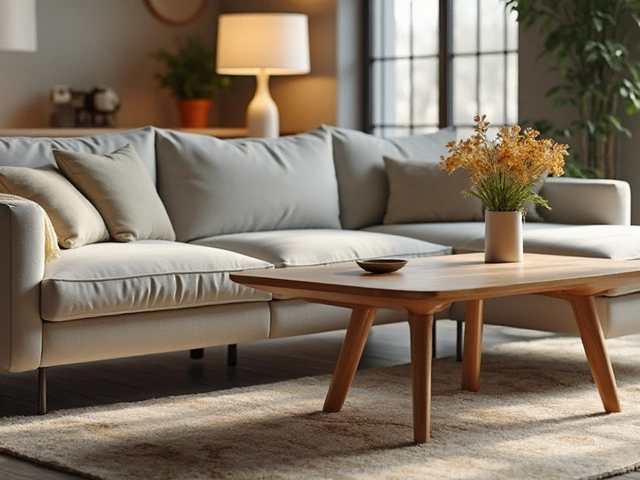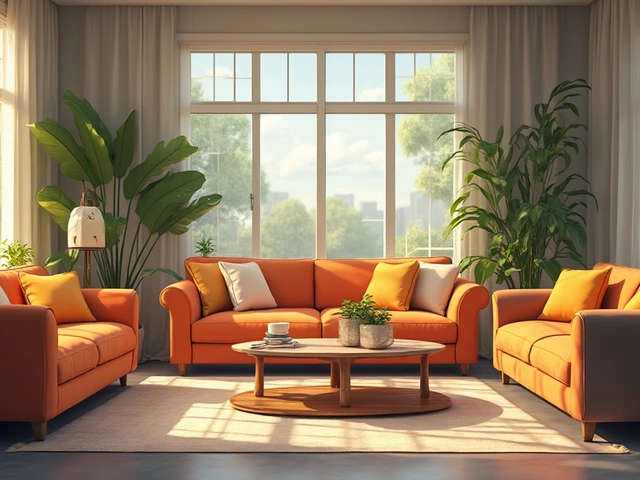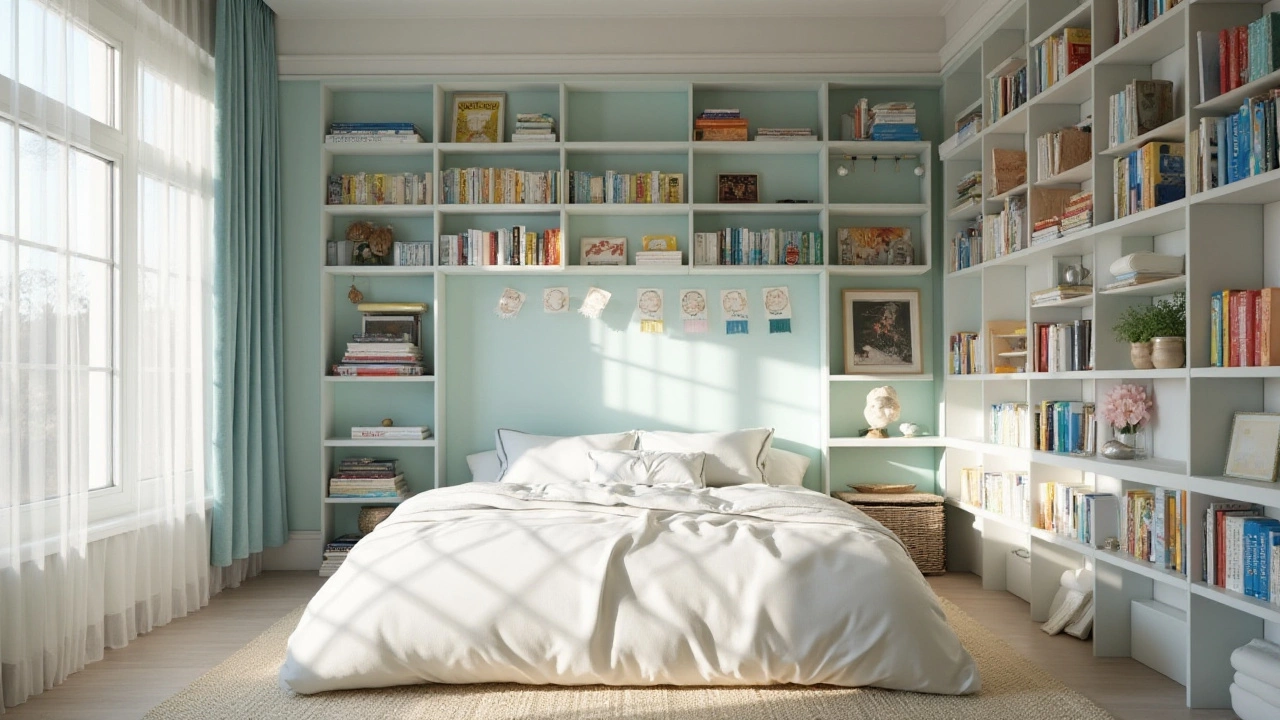
Small bedrooms often present a unique set of challenges, but they're also the perfect canvas for creativity. When it comes to making a small bedroom look amazing, it's all about how cleverly you can utilize the space and decor to your advantage. You might feel restricted by square footage, but there's a world of design opportunities awaiting those who think outside the box.
From the colors you choose to the furniture pieces you select, each decision plays a crucial role in defining the essence of your space. The aim isn't just to declutter, but to elevate the space into something that's both functional and aesthetically pleasing. Whether you're looking to create a cozy nook for relaxation or a crisp and contemporary retreat, the possibilities are endless when you have the right strategies in hand.
- Maximize Vertical Space
- Choose a Light Color Palette
- Opt for Multifunctional Furniture
- Incorporate Smart Storage Solutions
- Utilize Mirrors and Lighting
- Add Personal Touches
Maximize Vertical Space
When working with a small bedroom, making the most of every inch becomes a creative endeavor, and vertical space often holds the key to success. One of the most effective strategies is to build upwards, which means looking beyond what's at eye level and turning your attention to the walls. Start by hanging shelves high up to draw the eye upwards and give the illusion of a taller room. These shelves can be a perfect home for books, plants, or decorative items that double as art when arranged thoughtfully.
"Utilizing vertical space is akin to discovering a hidden room in your house—it adds a dimension often overlooked," says Jane Henderson, interior design expert.
Another brilliant move is to use tall, narrow furniture that doesn't command much floor space but reaches all the way up. Consider a wardrobe that embraces your ceiling's full height or a bookshelf that acts as a room divider. This type of furniture lends a more spacious feel by freeing up the floor area while still providing plenty of storage. Let us not forget about hooks and pegs, which are small but mighty tools. They can be placed strategically around the room for hanging everything from clothing and bags to jewelry, maximizing wall space without encroaching on the room's footprint.
For those blessed with high ceilings, consider layering by adding a loft bed or a bunk-style setup. Not only does this create a cozy sleeping area, but it also liberates floor space for a desk or a cozy reading nook underneath. It’s a win-win solution for anyone looking to create distinct zones within a single room. Sometimes, rearranging the layout of the room can reveal vertical possibilities. Experiment by placing the bed against different walls—often, this opens up areas previously overlooked, ready to host new storage solutions.
A practical yet visually appealing addition is a pegboard. Apart from being on-trend, pegboards are customizable, allowing you to rearrange and add compartments as your storage needs evolve. Incorporating art, like gallery walls, is another way to use vertical space without compromising on style. Stick to a cohesive theme or mix it up with varied frames and art styles to reflect your personal taste. Streamlining decorative elements on walls can help maintain an airy atmosphere, crucial in smaller spaces.
Think outside the box and extend this vertical approach to your window treatments. Using floor-to-ceiling curtains, even if your windows are not that tall, creates an illusion of grandeur and height. It’s amazing how much of an impact this simple change can make, tricking the eye into perceiving a larger space. Finally, implementing ladder racks can innovate how you store items, from towels and blankets to magazines and scarves. Ladders are not just functional; they offer warmth and texture, enhancing your room's aesthetic appeal.
Choose a Light Color Palette
When you're working with a small bedroom, color can be your greatest ally. One of the most effective ways to create an impression of space is by choosing a light color palette. Light colors, particularly whites and soft neutrals, reflect more light than their darker counterparts, which can do wonders in brightening up a room. This not only makes the room look more spacious but also has the added benefit of creating a calm and serene environment, which is ideal for a space meant for rest and relaxation. Imagine waking up in a room painted with soft pastels, where the morning sun casts gentle rays across your surroundings. Such a setting can truly transform daily mornings into delightful beginnings.
The psychology of color emphasizes that softer shades can positively affect mood. Lighter hues are often associated with tranquility and happiness. For instance, a gentle robin's egg blue can invoke a feeling of serenity reminiscent of a clear, summer sky, while a soft buttery yellow might evoke the warmth of sunshine. Both shades work harmoniously to make your room feel both expansive and inviting. An interesting pattern has emerged where young couples and professionals are gravitating towards these colors, driven by increased urbanization and the resultant smaller living spaces which make every square inch count. As noted by designer Emily Henderson, "A lighter palette doesn’t just brighten up a room—it breathes life into it."
If you're worried about a monochrome effect, fear not! You can introduce character and variation by layering different textures and accents in the room. Consider introducing pops of color through pillows, throws, or even a small rug. Textured elements such as woven throws or a knit bedspread can add dimension without overpowering the space. A crisp white wall, adorned with framed art or photographs, can also draw the eye vertically, again creating an illusion of a larger room. There's also the growing trend of two-tone or color blocking schemes with light on top and slightly deeper shades below, leading the eye upwards.
It's equally important to take into consideration the finish of the paint. A matte finish tends to absorb light, while an eggshell or satin finish can reflect it just enough to enhance the airy feel of the room. Balancing the mattes with glossier finishes could give the room a subtle and sophisticated growth in visual interest. Think about complementing your wall color with similar light-colored furnishings like a soft cream headboard or an off-white bedside table. Subtle additions can make a remarkable impact. Changing ceiling paint color can be another creative twist—going slightly lighter than the walls can add depth and dimension without closing off the space.
Choosing the right color palette is not just about aesthetics, it's about constructing a personal retreat that resonates with peace and expansiveness. The interplay of light shades can redefine your bedroom decor into a sanctuary that is as stylish as it is personal. Giving this approach the attention it deserves in a small bedroom can yield transformative results, allowing your personality and taste to shine through while managing space constraints intelligently.
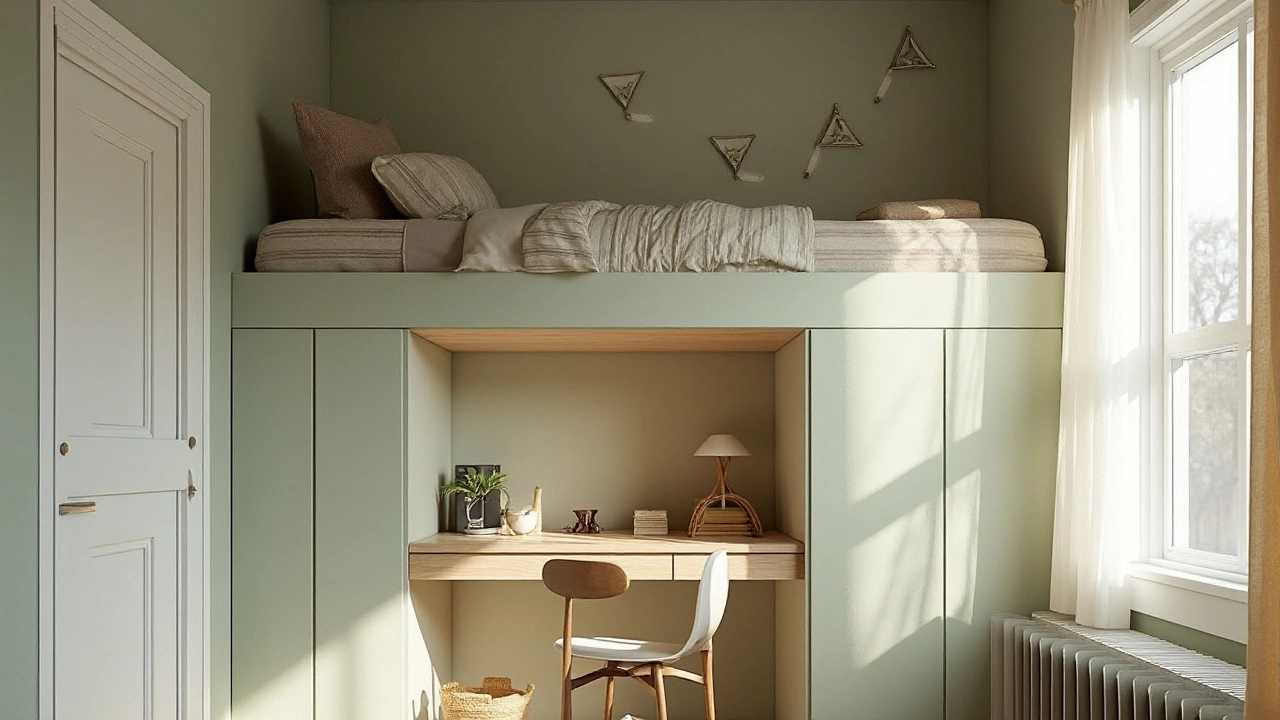
Opt for Multifunctional Furniture
For those living in a cozy abode, the introduction of multifunctional furniture can be nothing short of a revelation. Think of furniture pieces not as single-purpose items, but as Swiss Army knives of decor — versatile and full of hidden features. Transforming tables, fold-out beds, or benches with hidden storage are examples of this clever approach. The goal is to ensure that every piece you bring into your bedroom serves more than one duty. This way, you're not only saving space but also imbuing your room with a sense of thoughtful design. Imagine a sleek, modern bed that can pull out additional storage drawers underneath or a bedside table that is also a mini desk. Such ingenious solutions make a small bedroom feel significantly larger than its actual measurements portray.
A prime example of this can be found with storage beds, which are especially beneficial for compact living spaces. By elevating the mattress and cleverly integrating drawers or shelves underneath, you gain wonderful storage space without overshadowing the room's aesthetic. It might surprise you to learn that beds with storage can often accommodate as much as a standard dresser, significantly decluttering the room. To make it visually appealing, keep those storage elements closed and sleek, ensuring they don’t draw unnecessary attention.
Consider, for instance, the statement made by renowned interior designer Nate Berkus,
"Your space should feel like an intersection between functionality and style.”He suggests that smart design means making choices that reflect both your needs and aspirations without compromise. This could include incorporating a sofa-bed if your room doubles as a living space during the day, or utilizing a foldaway desk that transforms into a bedside table by night. The adaptability of your furniture should cater to your lifestyle as well as your space.
Let’s not forget the power of modular furniture, which is making waves due to its ability to adapt and evolve with the user's needs. Pieces that can be reconfigured reflect the ultimate pinnacle of multifunctional design. Perhaps you could invest in a modular shelving system that transitions from holding books one day to displaying art and decorative items the next. Such fluid changes not only refresh the bedroom’s face but do so effortlessly and stylishly, inviting constant reinvention.
Another noteworthy consideration is the integration of space-saving items such as wall-mounted desks and foldaway chairs. These are particularly useful in bedrooms that require an element of an office setup. When choosing multifunctional pieces, quality should not be overlooked. Opt for solid craftsmanship that guarantees durability. Keep an eye out for convertible desks that easily become make-up stations or chairs that double as step ladders for accessing higher storage, elucidating the fusion of practicality and eco-friendly ideas. The DIY community is abuzz with hacks and remedies to make ordinary furniture transform into something extraordinary.
In conclusion, if you’re going to transform your small bedroom into an inviting, clutter-free space, looking at interior design options with flexibility and creativity is crucial. The more you implement pieces that can adapt to the changing dynamics of life, the more conducive and intuitive your space becomes. Prioritize elements that add value in multiple forms, and you’ll have a small bedroom that doesn’t skimp on flair or functionality. Multifunctional furniture is the unsung hero of small bedroom decor, offering dynamic solutions for modern living.
Incorporate Smart Storage Solutions
When it comes to making the most of a small bedroom, thoughtful storage solutions can be a game-changer. The key is to integrate storage in a way that it becomes an integral part of your room’s design rather than just a functional afterthought. This means looking beyond the typical under-bed storage or wall shelves. Consider vertical and hidden storage options that keep the room tidy without sacrificing style. Tailor your storage to the items you own and the lifestyle you lead. For instance, if you are an avid reader, a built-in bookshelf around the bed or behind a door can save space while keeping your passion close at hand. Small bedroom decor can vastly benefit from such innovative approaches.
Another effective strategy is using multifunctional furniture that doubles up on utility. Ottomans with storage, beds with pull-out drawers, or benches with compartments can help hide away clutter while providing practical daily use. These pieces not only free up valuable floor space but also reduce the visual clutter, making the room feel more open. Utilizing every potential inch in your small bedroom is crucial, and often overlooked spaces such as corners or the back of doors can serve as excellent storage spots, especially for hanging bags, scarves, or even jewelry. This approach emphasizes both style and efficiency.
Closet organization is also essential in a small bedroom. Make it a rule to rotate seasonal clothes and use slim, uniform hangers to maximize space within a wardrobe. Hooks and pegboards can add extra storage by offering spots for hanging accessories. If you're inclined to keep some items visible, ensure they contribute aesthetically to the decor. A neatly arranged collection of hats or artfully displayed jewelry can double as a design element.
Some homeowners have taken to repurposing unusual items for storage, such as wine crates or wooden pallets, to create floating shelves or storage cubbies. This can be a sustainable and stylish choice, especially in a bohemian or rustic-themed room.
"An efficient storage system can transform a chaotic, cramped space into a serene and functional environment," says interior designer Sarah Robertson. "The trick is to be creative and open-minded about how space can be used."And indeed, the data backs this up: research from the National Association of Home Builders suggests homeowners can increase livable space by up to 400% with smart storage solutions, particularly in small rooms.
For a personalized touch, label containers to make accessing stored items easier and keep everything organized. Transparency in storage can help avoid the "out of sight, out of mind" trap, where belongings are forgotten, encouraging unnecessary accumulation of duplicates. Modern aesthetic storage solutions like wicker baskets, woven bins, and fabric boxes can add an element of style while keeping essentials at hand. As you can see, incorporating smart storage is about blending design with practicality to create a bedroom decor that truly reflects your needs and tastes without compromising on the aesthetic beauty of your small sanctuary.
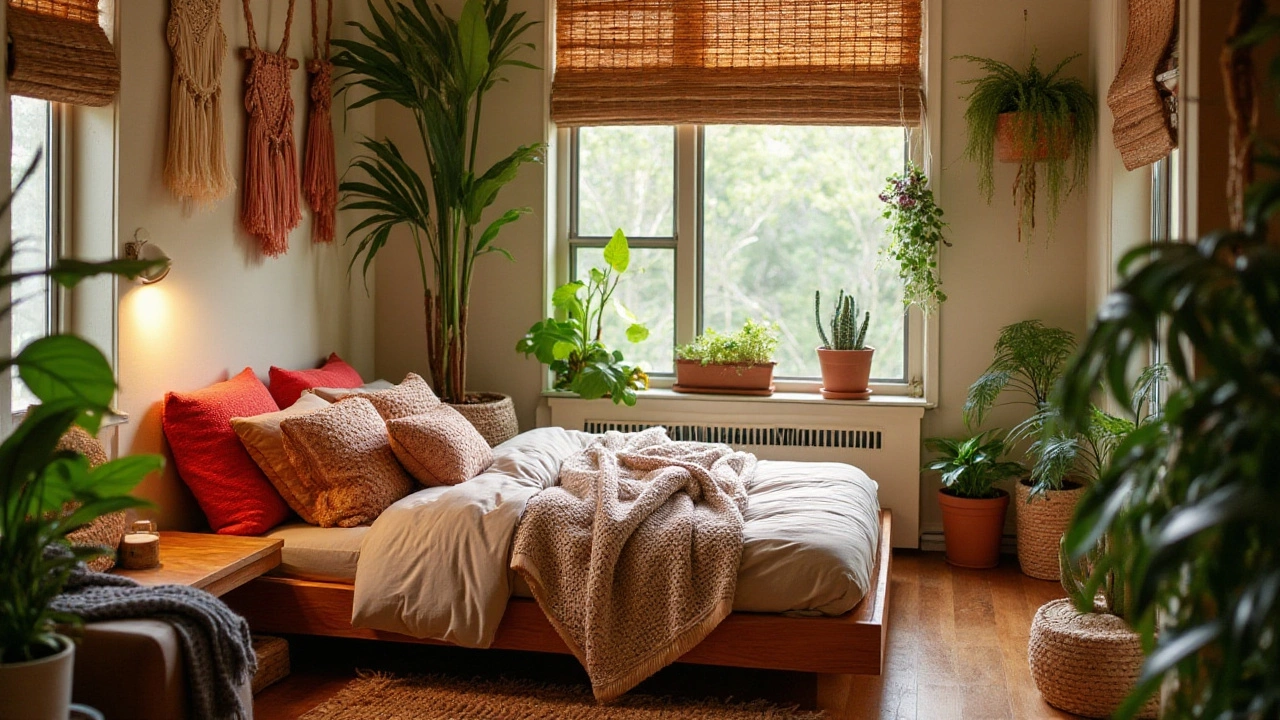
Utilize Mirrors and Lighting
Creating an illusion of a larger space in your small bedroom is all about being strategic with mirrors and lighting. Mirrors are magical when it comes to decorating small areas. They reflect light, increase brightness, and add depth, tricking the eye into perceiving a room larger than it actually is. Consider placing a large mirror directly across from a window to maximize natural light reflection. Doubling up on mirrors can be effective too; a pair of mirrors flanking a central piece like a bed can create a sophisticated symmetry and open up the space even more.
According to interior designer Nate Berkus, "Mirrors have the power to transform small spaces by enhancing light and adding dimensions." This insight into design highlights the necessity of putting mirrors to good use in compact rooms.
Beyond mirrors, the role of lighting cannot be overstated. Lighting can make or break the ambiance of your sleeping sanctuary, and in a small bedroom, the right lighting can do wonders. Prioritize layering your lights. Start with a central ceiling fixture to provide basic illumination and add depth by incorporating bedside lamps for reading or accenting with wall sconces to free up valuable surface space. Consider using dimmers to adjust the mood and brightness to your liking. Such flexibility allows your space to transition seamlessly from a vibrant daytime setting to a serene nighttime retreat.
Innovative lighting solutions also contribute to maximizing space. For instance, under-bed LED strips can add drama and functionality, lighting up tricky corners that are typically left unnoticed. Also, consider using floor lamps in darker corners to spread light evenly across the room. Importantly, try to match the lighting temperature to create a cozy and balanced atmosphere. Using warm versus cool light can distinctly change the feel of your room. Let's not forget about the option of pendant lights, which can add an element of elegance without consuming horizontal space—an ideal solution for striking a balance between style and function in smaller settings.
Add Personal Touches
When it comes to transforming your small bedroom from a mere sleeping area into a true reflection of your personality, adding personal touches is where the magic happens. It's not just about decorating with objects you like, but about weaving pieces of your life and experiences into the very fabric of the room. Start by selecting artwork that speaks to you. This could be anything from family photos to prints from your favorite artists or even your own creations. Arranging them in a gallery wall can make a stunning statement, especially if you play with diverse frame styles and sizes.
Don’t overlook textiles, which include bedding, curtains, and rugs — these elements greatly influence the mood of the room. Choose fabrics that resonate with your sense of style. Whether you gravitate toward whimsical patterns or prefer minimalist textures, these fabrics will introduce warmth and character to your space. Personalization can also extend to your choice of scents, using candles or diffusers that carry memories or simply uplift your spirit. Kaisa Robenholt, a leading interior designer, once said,
"A room should never allow the eye to settle in one place. It should smile at you and create fantasy."
Beyond aesthetics, consider integrating cherished items that tell a story — perhaps a vintage trinket from your travels or a piece of your grandmother’s handcrafted lace. If you have a knack for crafts, create something unique for your bedroom like custom pillow covers or painted vases. Bedroom decor is about layering these elements in a way that feels natural and not overly cluttered, making sure each piece has space to shine. At the heart of personalizing your small bedroom is the idea of balance — it's essential not to crowd the space, but rather curate it with meaningful additions that resonate with you, so that it becomes more than just a place to sleep.

